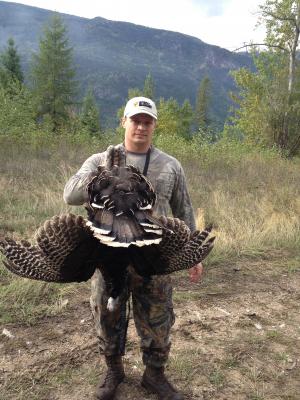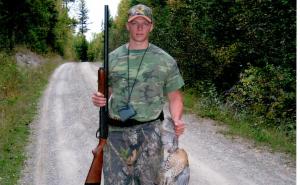All About Shotguns and Shotgun Loads
Shotgun gauges, Shotgun applications, Shotgun types, Shot sizes:
 Shotguns are commonly used for bird shooting, small game hunting, sports -like skeet, trap and sporting clay shooting and also by law enforcing agencies that use shotguns for controlling crowds and riots using rubber bullets or beanbags for ammunition. In the military shotguns are used as special purpose weapons. US naval vessels and military police use shotguns for shipboard security.
Shotguns are commonly used for bird shooting, small game hunting, sports -like skeet, trap and sporting clay shooting and also by law enforcing agencies that use shotguns for controlling crowds and riots using rubber bullets or beanbags for ammunition. In the military shotguns are used as special purpose weapons. US naval vessels and military police use shotguns for shipboard security.
Shotgun ammunition consists of loads made from gunpowder and multiple spherical lead/ steel or alloy metal pellets or a single solid slug contained in a paper or plastic shell. The shot carries much less punch as compared to a rifle bullet because the energy of the charge is distributed among individual pellets. The pellets spread out after leaving the barrel of the shotgun and therefore are able to hit a wide target area rather than a specific spot on some target. This makes them ideal for shooting single/flock of game birds whether at the ground or in flight.
The low muzzle velocity of the single slug from a shotgun is an advantage when hunting deer in semi-populated areas, where high-powered rifle ammunition is considered too great a hazard due to its power and range. A typical rifle round (.308) used for deer hunting has a 7.62-mm/150 grain bullet with a lethal range of several miles, whereas the shotgun slug would be approx. 18mm/462 grain with a range of just a few hundred yards. The difference in weapon construction (rifle and shotgun) as also the ammunition caters to a drastic change in projectile dynamics making a great difference in reach and the resulting wound. Due to its tremendous mass a shotgun slug is able to create a lethal wound for a humane kill at short range lessening the time of animal suffering, while its short range and inability to penetrate solid mass makes it a safer alternative to a bullet in designated areas.
There are many types of shotguns to suit individual preferences of hunters. They can be single barreled or double barreled. Double-barreled shotguns can be ‘side by side’ or ‘over and under’, the names distinguishing, how both barrels are placed in relation to each other. Each barrel may be of a different gauge (size) or one barrel cylindrical while the other is choked being either smooth or rifled. The gun may come with hammers or may be of the hammerless type. In a break open type shotgun, shell ejection and gun cocking are done in one movement, as the gun is broken open to expose the breach by lowering the hinged barrel a few inches. Semi automatic shotguns are equipped with lever action or pump action to eject a fired shell and load a fresh one in the breech by operating the action. In the lever action shotgun, the trigger and trigger guard assembly all move back and forth in a semi arc to complete the action, where as in the pump action there is a sliding cylinder that moves over a fixed cylinder located under the barrel. The spent shell is ejected and a fresh one loaded by moving the sliding cylinder in a swift back and forth action once. Auto loaders use the gas or recoil power from a fired shot to automatically eject a spent shell and load a fresh one. In the US and Canada there are waterfowl hunting restrictions that limits the capacity of shotgun magazines to 3 shells, which negates the advantages such shotguns have over double-barreled ones.
Remington, Winchester, Mossberg, Weatherby, Bennelli, Beretta, Browning, Franchi, and Ithaca are some reputed names in shotguns. There are countless models available and the Winchester Parker, Weatherby Orion Upland and Athena Grade IV, Browning Citori Feather XS, Remington Model 300 Ideal, USRAC/Winchester Supreme, Weatherby SAS, Remington 870, Remington 870 Wingmaster, Benelli Nova, USRAC/ Winchester Model 1300 Ranger, Browning BPS and Mossberg Model 500 Sporting are to name just a few.
Shotgun sizes are denoted by gauges unlike rifles, which are ‘sized’ by calibers representing the bore diameter of the rifle barrel. Shotguns are available in 10,12,16,20 and 28 gauges (sizes). A higher gauge number represents a smaller shotgun barrel diameter. Hence, a 10 gauge shotgun is larger than 12 gauge one, which in turn is larger than 16 gauge and so on. The smallest shotgun is available in .410, which is an exception in shotgun size denoting caliber and not gauge.
The gauge system of shotgun bore size measurement is rather unique and can be understood by the original method of such measurement based on the number of lead spheres made in a size to smoothly fit a gun barrel to equal one pound of lead. Simply stated, 10 lead balls diametrically equal to the 10-gauge shotgun barrel bore will weigh one pound. For a 20-gauge size, 20 lead balls fashioned similarly would constitute one pound in weight.
Ammunition is available to suit shotguns of different gauges and for hunting purposes can be placed in two broad categories, birdshot and buckshot. Shots or pellets called payload used in the ammunition are also of different sizes and are indicated by a number printed/stamped on the shell. Similar to gauge size a bigger number indicates a smaller pellet size. As the number goes higher, payload quantity, pellet size and powder charge in the shell get smaller.
In birdshot the smallest shot size is number 9 with pellets having a nominal diameter of 2.03mm. Progressively larger size shots are number 8,71/2, 6, 5, 4, 3, 2, 1, B, BB, BBB, T, F and FF. The largest birdshot pellets FF are 5.84mm in diameter. The pellets are made from high density metal like lead or alloys like steel etc.
Buckshot as the name suggests is mostly used for hunting deer and similar sized game animals. Buckshot sizes, from small to big, are numbered as 4,3,2,1, 0, 00, 000 with the last three called ‘ought’, ‘double ought’ and ‘triple ought’ respectively. The smallest buckshot pellet size #4 is 6mm in diameter (as against 3.3 mm for a #4 birdshot pellet). Buckshot pellet size gradually increases to 9.1 mm for 000 (triple ought). These sizes are in addition to the singe solid lead slug that weighs 1oz/5/8oz. .
Allowing for individual preferences and hunting conditions guns, shells and shots of the following gauges/sizes would be found suitable for bird shooting. It is important to note that legal restrictions at many places prohibit the use of lead shots for shooting over water areas, to prevent lead contamination, requiring hunters to use shots of metal/alloy other than lead.
GAUGE SHOT TYPE/SIZE GAME
10, 12 Steel, T, BBB, BB, GEESE
10, 12, 20 Steel, 1,2,3,4,6 DUCKS
10,12,16,20 Lead, 4,5,6 TURKEY
12,16,20 Lead, 4,5,6,71/2 PHEASANT
12,20 Steel, 4,6 PHEASANT
12,16,20,28 Lead, 5,6,71/2,8 GROUSE
12,16,20,28 Lead, 5,6,71/2,8 PARTRIDGE
12,20 Steel, 4,6,7 SNIPE
12,16,20,28,410 Lead, 71/2,8 DOVE
12,20 Steel, 4,6,7 DOVE
12,16,20,28,410 Lead, 4,5,6, 71/2 RABBIT
Six different gauges from which a hunting shotgun may be selected are10, 12, 16, 20, 28 and 410.Shot shells compatible to different gauges consist of loads having varying amounts of powder and shot size/quantity. Not every gauge is suitable for all hunting needs. Guns of 10 and 12 gauge sizes are the most popular and best suited to handle buckshot.


